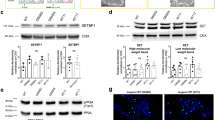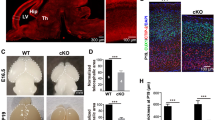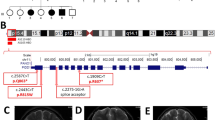Abstract
Initially identified in high-grade gliomas, mutations in the PTEN tumor-suppressor are also found in many sporadic cancers and a few related autosomal dominant hamartoma syndromes. PTEN is a 3′-specific phosphatidylinositol-3,4,5-trisphosphate (PI(3,4,5)P3) phosphatase and functions as a negative regulator of PI3K signaling. We generated a tissue-specific deletion of the mouse homolog Pten to address its role in brain function. Mice homozygous for this deletion (PtenloxP/loxP;Gfap-cre), developed seizures and ataxia by 9 wk and died by 29 wk. Histological analysis showed brain enlargement in PtenloxP/loxP;Gfap-cre mice as a consequence of primary granule-cell dysplasia in the cerebellum and dentate gyrus. Pten mutant cells showed a cell-autonomous increase in soma size and elevated phosphorylation of Akt. These data represent the first evidence for the role of Pten and Akt in cell size regulation in mammals and provide an animal model for a human phakomatosis condition, Lhermitte-Duclos disease (LDD).
This is a preview of subscription content, access via your institution
Access options
Subscribe to this journal
Receive 12 print issues and online access
$209.00 per year
only $17.42 per issue
Buy this article
- Purchase on Springer Link
- Instant access to full article PDF
Prices may be subject to local taxes which are calculated during checkout







Similar content being viewed by others
References
Li, J. et al. PTEN, a putative protein tyrosine phosphatase gene mutated in human brain, breast, and prostate cancer. Science 275, 1943–1947 (1997).
Steck, P.A. et al. Identification of a candidate tumour suppressor gene, MMAC1, at chromosome 10q23.3 that is mutated in multiple advanced cancers. Nature Genet. 15, 356–362 (1997).
Simpson, L. & Parsons, R. PTEN: life as a tumor suppressor. Exp. Cell. Res. 264, 29–41 (2001).
Maehama, T. & Dixon, J.E. The tumor suppressor, PTEN/MMAC1, dephosphorylates the lipid second messenger, phosphatidylinositol 3,4,5-trisphosphate. J. Biol. Chem. 273, 13375–13378 (1998).
Stambolic, V. et al. Negative regulation of PKB/Akt-dependent cell survival by the tumor suppressor PTEN. Cell 95, 29–39 (1998).
Haas-Kogan, D. et al. Protein kinase B (PKB/Akt) activity is elevated in glioblastoma cells due to mutation of the tumor suppressor PTEN/MMAC. Curr. Biol. 8, 1195–1198 (1998).
Sun, H. et al. PTEN modulates cell cycle progression and cell survival by regulating phosphatidylinositol 3,4,5,-trisphosphate and Akt/protein kinase B signaling pathway. Proc. Natl Acad. Sci. USA 96, 6199–6204 (1999).
Liaw, D. et al. Germline mutations of the PTEN gene in Cowden disease, an inherited breast and thyroid cancer syndrome. Nature Genet. 16, 64–67 (1997).
Marsh, D.J. et al. Germline mutations in PTEN are present in Bannayan-Zonana syndrome [letter]. Nature Genet. 16, 333–334 (1997).
Marsh, D.J. et al. Germline PTEN mutations in Cowden syndrome–like families. J. Med. Genet. 35, 881–885 (1998).
Marsh, D.J. et al. PTEN mutation spectrum and genotype–phenotype correlations in Bannayan-Riley-Ruvalcaba syndrome suggest a single entity with Cowden syndrome. Hum. Mol. Genet. 8, 1461–1472 (1999).
Eng, C. & Peacocke, M. PTEN and inherited hamartoma-cancer syndromes [letter]. Nature Genet. 19, 223 (1998).
Wiestler, O.D., Padberg, G.W. & Steck, P.A. Cowden disease and dysplastic gangliocytoma of the cerebellum/Lhermitte-Duclos disease. in Pathology and Genetics of Tumors of the Nervous System (eds. Kleihues, P. & Cavenee, W.K.) 235–237 (IARCPress, Lyon, 2000).
Holland, E.C. et al. Combined activation of Ras and Akt in neural progenitors induces glioblastoma formation in mice. Nature Genet. 25, 55–57 (2000).
Ding, H. et al. Astrocyte-specific expression of activated p21-ras results in malignant astrocytoma formation in a transgenic mouse model of human gliomas. Cancer Res. 61, 3826–3836 (2001).
Di Cristofano, A., Pesce, B., Cordon-Cardo, C. & Pandolfi, P.P. Pten is essential for embryonic development and tumour suppression. Nature Genet. 19, 348–355 (1998).
Suzuki, A. et al. High cancer susceptibility and embryonic lethality associated with mutation of the PTEN tumor suppressor gene in mice. Curr. Biol. 8, 1169–1178 (1998).
Podsypanina, K. et al. Mutation of Pten/Mmac1 in mice causes neoplasia in multiple organ systems. Proc. Natl Acad. Sci. USA 96, 1563–1568 (1999).
Stambolic, V. et al. High incidence of breast and endometrial neoplasia resembling human Cowden syndrome in pten+/− mice. Cancer Res. 60, 3605–3611 (2000).
Kwon, C.H. et al. Pten regulates neuronal soma size: a mouse model for Lhermitte-Duclos disease. Nature Genet. 29, 404–411 (2001).
Suzuki, A. et al. T cell–specific loss of Pten leads to defects in central and peripheral tolerance. Immunity 14, 523–534 (2001).
Lachyankar, M.B. et al. A role for nuclear PTEN in neuronal differentiation. J. Neurosci. 20, 1404–1413 (2000).
Myers, M.P. et al. The lipid phosphatase activity of PTEN is critical for its tumor supressor function. Proc. Natl Acad Sci. USA. 95, 13513–13518 (1998).
Dahia, P.L. et al. PTEN is inversely correlated with the cell survival factor Akt/PKB and is inactivated via multiple mechanisms in haematological malignancies. Hum. Mol. Genet. 8, 185–193 (1999).
Ramaswamy, S. et al. Regulation of G1 progression by the PTEN tumor suppressor protein is linked to inhibition of the phosphatidylinositol 3-kinase/Akt pathway. Proc. Natl Acad. Sci. USA. 96, 2110–2115 (1999).
Bruni, P. et al. PTEN expression is reduced in a subset of sporadic thyroid carcinomas: evidence that PTEN-growth suppressing activity in thyroid cancer cells mediated by p27kip1. Oncogene 19, 3146–3155 (2000).
Hampe, C.S. et al. A novel monoclonal antibody specific for the N-terminal end of GAD65. J. Neuroimmunol. 113, 63–71 (2001).
Wuenschell, C.W., Fisher, R.S., Kaufman, D.L. & Tobin, A.J. In situ hybridization to localize mRNA encoding the neurotransmitter synthetic enzyme glutamate decarboxylase in mouse cerebellum. Proc. Natl Acad. Sci. USA. 83, 6193–6197 (1986).
Norenberg, M.D. Astrocyte responses to CNS injury. J. Neuropathol. Exp. Neurol. 53, 213–220 (1994).
Karle, J., Woldbye, D.P. & Diemer, N.H. GABAA receptor antisense epilepsy: histological changes following infusion of antisense oligodeoxynucleotide to GABAA receptor γ2 subunit into rat hippocampus. Neurol. Res. 23, 39–46 (2001).
Nishio, S., Morioka, T., Hisada, K. & Fukui, M. Temporal lobe epilepsy: a clinicopathological study with special reference to temporal neocortical changes. Neurosurg. Rev. 23, 84–89 (2000).
Khurgel, M. et al. Activation of astrocytes during epileptogenesis in the absence of neuronal degeneration. Neurobiol. Dis. 2, 23–35 (1995).
Datta, S.R., Brunet, A. & Greenberg, M.E. Cellular survival: a play in three Akts. Genes. Dev. 13, 2905–2927 (1999).
Stambolic, V., Mak, T.W. & Woodgett, J.R. Modulation of cellular apoptotic potential: contributions to oncogenesis. Oncogene 18, 6094–6103 (1999).
Goldowitz, D. & Hamre, K. The cells and molecules that make a cerebellum. Trends Neurosci. 21, 375–382 (1998).
Huang, H. et al. PTEN affects cell size, cell proliferation and apoptosis during Drosophila eye development. Development 126, 5365–5372 (1999).
Goberdhan, D.C., Paricio, N., Goodman, E.C., Mlodzik, M. & Wilson, C. Drosophila tumor suppressor PTEN controls cell size and number by antagonizing the Chico/PI3-kinase signaling pathway. Genes. Dev. 13, 3244–3258 (1999).
Scanga, S.E. et al. The conserved PI3'K/PTEN/Akt signaling pathway regulates both cell size and survival in Drosophila. Oncogene 19, 3971–3917 (2000).
Rakic, P. Role of cell interaction in development of dendritic patterns. Adv. Neurol. 12, 117–134 (1975).
Privat, A. & Drian, M.J. Postnatal maturation of rat Purkinje cells cultivated in the absence of two afferent systems: an ultrastructural study. J. Comp. Neurol. 166, 201–243 (1976).
Sotelo, C. & Arsenio-Nunes, M.L. Development of Purkinje cells in absence of climbing fibers. Brain Res. 111, 289–295 (1976).
Morrison, M.E. & Mason, C.A. Granule neuron regulation of Purkinje cell development: striking a balance between neurotrophin and glutamate signaling. J. Neurosci. 18, 3563–3573 (1998).
Voogd, J. & Glickstein, M. The anatomy of the cerebellum. Trends Neurosci. 21, 370–375 (1998).
Babb T, B.W. Pathological findings in epilepsy. in Surgical Treatment of Epilepsies (ed. Engel, J.) 511–540 (Raven Press, New York, 1987).
Dorland, W.A. Dorland's Illustrated Medical Dictionary, 2088 (WB Saunders, New York, 2000).
Vinchon, M. et al. Association of Lhermitte-Duclos and Cowden disease: report of a new case and review of the literature. J. Neurol. Neurosurg. Psychiatry 57, 699–704 (1994).
Roessmann, U. & Wongmongkolrit, T. Dysplastic gangliocytoma of cerebellum in a newborn. Case report. J. Neurosurg. 60, 845–847 (1984).
Iida, S. et al. A heterozygous frameshift mutation of the PTEN/MMAC1 gene in a patient with Lhermitte-Duclos disease—only the mutated allele was expressed in the cerebellar tumor. Int. J. Mol. Med. 1, 925–929 (1998).
Zhou, X.P. et al. Germline and germline mosaic PTEN mutations associated with a Proteus-like syndrome of hemihypertrophy, lower limb asymmetry, arteriovenous malformations and lipomatosis. Hum. Mol. Genet. 9, 765–768 (2000).
Zhou, X. et al. Association of germline mutation in the PTEN tumour suppressor gene and Proteus and Proteus-like syndromes. Lancet 358, 210–211 (2001).
Biesecker, L.G. et al. Proteus syndrome: diagnostic criteria, differential diagnosis, and patient evaluation. Am. J. Med. Genet. 84, 389–395 (1999).
Griffiths, P.D., Welch, R.J., Gardner-Medwin, D., Gholkar, A. & McAllister, V. The radiological features of hemimegalencephaly including three cases associated with proteus syndrome. Neuropediatrics 25, 140–144 (1994).
Steward, O., Torre, E.R., Tomasulo, R. & Lothman, E. Seizures and the regulation of astroglial gene expression. Epilepsy. Res. Suppl. 7, 197–209 (1992).
Acknowledgements
We thank S. Baker for providing Gfap-cre mice and discussing data before publication, K. So, L. Yoong, S. Plyte, W. King, J. Henderson and J. Robertson for technical assistance and S. Pownall, A. Guha and M. Burnham for helpful comments and discussion. V.S. is a recipient of a postdoctoral fellowship from the Cancer Research Institute, New York. This work is supported by the National Cancer Institute of Canada and the Canadian Breast Cancer Research Initiative.
Author information
Authors and Affiliations
Corresponding author
Rights and permissions
About this article
Cite this article
Backman, S., Stambolic, V., Suzuki, A. et al. Deletion of Pten in mouse brain causes seizures, ataxia and defects in soma size resembling Lhermitte-Duclos disease. Nat Genet 29, 396–403 (2001). https://doi.org/10.1038/ng782
Received:
Accepted:
Published:
Issue Date:
DOI: https://doi.org/10.1038/ng782
This article is cited by
-
The Hole-Board Test in Mutant Mice
Behavior Genetics (2022)
-
Glial cell type-specific gene expression in the mouse cerebrum using the piggyBac system and in utero electroporation
Scientific Reports (2021)
-
Modelling genetic mosaicism of neurodevelopmental disorders in vivo by a Cre-amplifying fluorescent reporter
Nature Communications (2020)
-
Unique properties of PTEN-L contribute to neuroprotection in response to ischemic-like stress
Scientific Reports (2019)
-
Therapeutic inhibition of mTORC2 rescues the behavioral and neurophysiological abnormalities associated with Pten-deficiency
Nature Medicine (2019)



